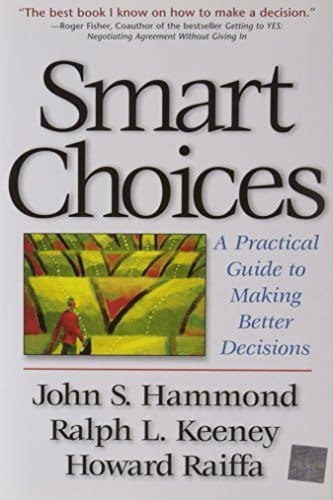
| Author | John S. Hammond & Others |
| Publisher | Harvard Business school press |
| language | English |
| Book Type | Paperback |
| ISBN-10 | 9780875848570 |
| Pages | 244 |
smart choices is a book written by authors from academic origination. John S. Hammond is a former professor at Harvard business school. He is a Decision-making consultant in the field of negotiation and corporate strategy. Ralph L. Keeney is a professor in Marshall School of business at the University of Southern California. A decision-making consultant and a member of the National Academy of Engineering. Howard raffia is a professor emeritus at Harvard business school . He is a pioneer in developing decision and negotiating analysis.
We can see from the author’s background this book is mainly for high-level education people as it is concentrated on decision making. As a reader and upon completing the book, you will realize various things. The book, in its simplicity not only in the language written but also in the content examples and explanations is targeted to any type of reader regardless his/her educational background. High school student, university student, new graduates, Architects, engineers, planners, marketers, salespeople and even people with limited education can benefit from the content of this book. In many areas, it comprises high-level knowledge simplified for the readers.
The book theme is centered on a new way/method to follow in making a decision. The book focus on thinking of the problem in a rational way and conducting analysis as well as running a risk assessment. The way/method leading to better decision in life or work and business to achieve success. Changing a person’s style of thinking to a smart decision maker.
As stated in the book introduction, decision making is a taught skill in its own right and there are few courses and few books in this genre. The book bridges the gap between how people take decision and researchers have discovered from experience on how the decision making should be. The way/method introduced in this book makes a person grow more and more comfortable with the process and techniques used in the decision-making activity.
As a reader, the book does not fall into the category of books written for education purpose. The book in many areas of it comprises decision-making methods and theories presented in a very simplified way. For example, the decision tree, desirability curve, and risk assessment methods. The examples from practice in decision making in the various chapters of the book were used to explain these methods and theories as an application of them in a real-life problem. The book is not meant to be as a reference for higher education research, but it could be used to understand the methods mentioned above.
Smart choices are taken when a series of steps are applied to a specific problem. Meaning every step is linked to another like branches of trees. The author’s smartness comes in connecting the chapters and the introduced decision-making steps in a couple of examples to make the ideas of the chapters more clear and easy to understand. The way/method and its proposed steps could be used at any time and it is relevant to this day’s knowledge of decision-making methods and techniques. The chapters include some graphs, figures relevant to the examples mentioned as well as numeric tables.
The authors repeat the idea of smart choices in every chapter of the book. As the title of the book shows, the content is guidelines to achieve smart choices. The book index reveals its chapter’s content and opens the way for the reader to predict what he is going to read inside the book. Smart choices are the choices when the series of steps are applied efficiently to a problem, as mentioned in the book.
You can find in several chapters reference to a couple of researches and studies to discuss the chapter idea. In other area of the book, the author refers to personal survey and case study on specific problem relevant to the chapter idea. In every chapter, there is a note referring to a research, study, or a reference related to the chapter idea.
I may ask why I should read this book. When a professor talked about this book, my desire to read the book increased. I asked myself in all my 25 years of professional practice I have made hundreds of decisions related to work and to the jobs I applied for. Some of these decisions were damaging and affected my career. So what are smart decisions and how do they defer from the ones I took. After reading the book, I realized that most of my decisions were using rational judgment. But not using advanced analysis methods like multi-criteria analysis and the method here in this book that gave the same results if I were to use this method.
In comparing this method to real-world problems I faced, I realized that experience plays a big role in the decision-making process. To take an accurate and successful decision professional will refer to his past experience related to the problem he is facing. The major element to take care of achieving accurate and successful decision is understanding uncertainty, to reduce it to the minimum level and to prepare an action plan for the possible undesirable outcomes of a certain decision. For further information on the analysis techniques you can read my book click here. And future book release a on the decision making in professional practice you can read my book Click here.
Be First to Comment